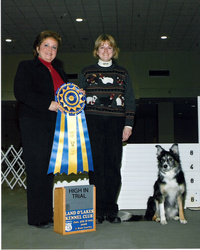Course Details
Over the years, I have seen a need for a different approach to teaching and handling dogs during weave pole training. The typical approach is to keep things simple and gradually build the dog's performance into 12 closed poles. Most dogs learn weave poles fairly quickly, but eventually start making mistakes because they never learned how to navigate the poles without handler assistance, position, or easy straight-ahead or handler-assisted pathways.
Many dogs learn to slow down to enter correctly. When the dog starts trialing, the weave performance can start reasonably well. The dog is still thinking a lot, and speed hasn’t increased.
Dogs that pick up speed and confidence with their weave performance while trialing can have issues using their bodies to enter the first gap correctly. Their timing is off, the entry is missed, a pole gets skipped, or the dog will pop out when they can’t hold on to the eventual angle into the next gap. Trainers refer to this as a need for the dog to learn how to “collect”, but (in my opinion) this isn’t exactly what the dog needs to learn. If you watch well-trained dogs with beautiful, independent weave entrances, there is a weight shift right before the dog positions itself for the entry. Because of this weight shift, dogs occasionally add a collection stride, but the weight shift causes this, and I don’t believe teaching dogs to collect will solve weave pole entry issues.
When speed increases, the mistakes gradually erode the dog's confidence. The many incorrect responses, poor handling, and negative responses from the handler further cause weave performance stress. Once that sets in, it can be more challenging to fix the weave performance.
I've used a modified 2 x 2 method to teach weave poles to all my dogs, and with a few adjustments over the years, I have been highly successful using this as a base. Plenty of other trainers successfully teach weave poles to their dogs using channels, wires, gates, or cages. Everyone eventually gets to the same place. My thoughts are not to change others' approaches but to strengthen my own.
My goal for teaching weaves to my young Border Collie, Vici, was to develop a procedure that increased energy, enthusiasm, and movement into and out of the weaves, while setting her up to learn how to use her body to find the entry, stay in until the exit, and focus ahead on the exit. We have worked through many common weave issues (incorrect entries, skipped poles, and exits) while she has lots of drive through the poles.
If you have a dog with weave stress at the trials or a dog that struggled learning weave performance, this class can build back confidence in both of you. If you have a young dog ready to train weaves and want to try a different approach, I'd love to show you one that is fun for both of you.
I have videos of all the stages with my young Border Collie, Vici (a medium dog). As others work through this class, videos of dogs with less drive and different sizes will be added to the lectures.
Teaching Approach
This class takes a step-by-step approach to building weave pole training. Each step will have written instructions and at least one video example. Lectures are released in one batch at the beginning of the week. Feedback will be mainly written, but occasionally, voiceover videos help the student understand subtle changes that are difficult to describe.
This class will have a Teacher's Assistant (TA) in the Facebook study group to help the Bronze and Silver students. Directions for joining that Facebook group will be in the classroom after you register.
 Instructor: Nancy Gagliardi Little
Instructor: Nancy Gagliardi LittleNancy Gagliardi Little (she/her) has been training dogs since the early 1980s, when she put an OTCH on her Novice A dog, a Labrador retriever. Since then she has put many advanced obedience titles on her dogs, including 4 AKC OTCH titles, 6 UD titles, 3 UDX titles, and multiple...(Click here for full bio and to view Nancy's upcoming courses)


